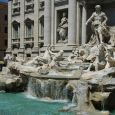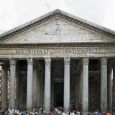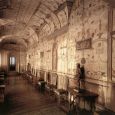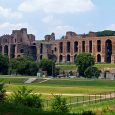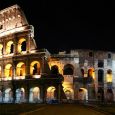Rome
Advertisement
By Air
Rome has two airports, although Fiumicino Airport handles most of the international flights and all of the domestic flights into the city. The smaller Ciampino Airport, located about 20kms south of the city, is primarily used by charter flights and budget carriers.
From Fiumicino Airport, there are two trains which head to the city centre. Alternatively, you can hire a taxi or a private limousine at booths in the Arrivals Hall. Regular bus service connects Fiumicino with downtown Rome and there is also a night bus service to Stazione Tiburtina. From Ciampino Airport, you can take a COTRAL bus, which connects with the Metro system, or you can hire a taxi.
By Rail
Romes central train station, the Stazione Termini, will connect you with every other train station in Italy. The station is located just east of the city centre, within a 15-minute walk of Piazza Vittorio and the Colosseo. There are English-speaking staff at the information office at the central station and you can purchase tickets up to two months in advance. Tickets can also be bought at most travel agencies or at the electronic ticket machines in the station, which have English instructions.
Romes other train stations, Tiburtina and Ostiense, service a handful of long-distance trains, commuter trains and the FM1 line to Fiumicino Airport. Trastevere Station handles some of the trains bound for Pisa and Genoa.
By Bus
There is no central bus station in Rome itself. Long-distance buses terminate either near the Tiburtina train station or near the outlying Metro stops, such as Anagnina and Rebbibia. Taking a bus is not the most convenient way to get to Rome, but it can be done. Once you arrive at one of the outlying stations, you simply need to use the local suburban bus company, COTRAL, to get into the city centre.
By Car
Rome is surrounded by an urban ring road, which connects with major motorways heading off in each of the four directions. From Milan and Florence to the north, you can take the A1 (Autostrada del Sole) or the A12-E80 motorway from Genoa.
Anyone travelling from the south, including Naples, can take the A2, which leads directly to Rome. From the airport, the A12 motorway will lead you straight into the city. All of the surrounding motorways connect with the Grande Raccordo Anulare (GRA), which channels the traffic towards the city centre. Like the rest of Italy, signs with a bulls eye will direct you to the centre of town.
Colosseum
The Colosseum, or Flavian Amphitheatre, is the largest structure left to us by Roman antiquity, and has provided the model for sports areas right down to modern times; the football stadia of the present day have basically the same form as this monument created by the architects of the Flavian Emperors, Vespasian and Titus. The object of the Emperors in raising the Colosseum was to satisfy the appetite of the Roman populace for circenses (games), and there is no doubt that they achieved their aim.
A bronze cross in the arena commemorates the Christian martyrs who were believed to have died here during the Roman Imperial period. There is some doubt, however, whether large numbers of Christians in fact met their death in the Colosseum. The structure of the Colosseum is so well preserved that it still creates a powerful impression of its original form, but it bears very evident marks of the damage and destruction it has suffered down the centuries - by fire, earthquake, neglect and dilapidation under the Christian Empire (when the games were abandoned), its conversion into a fortress of the Frangipane family, the pillaging of its marble, travertine and brick for the construction of palaces and the constant thunder of modern traffic. The building of the Colosseum was begun by Vespasian in A.D. 72 on the site of a colossal statue of Nero (hence the name Colosseum) which stood within the precincts of Nero's Domus Aurea. Vespasian's son Titus enlarged the structure by adding the fourth storey, and it was inaugurated in the year 80 with a series of splendid games. The Colosseum was oval in form (though it appears to be almost circular), 186m/610ft long by 156m/510ft across, with an arena 78 x 46m/260x150ft which could be used for theatrical performances, festivals, circus shows or games. It stood 57m/190ft high and could accommodate some 50,000 spectators - the Imperial court and high officials on the lowest level, the aristocratic families of Rome on the second level, the populace on the third and fourth. Around the exterior, built of travertine, are pilasters - of the Doric order on the ground floor, Ionic on the next tier and Corinthian on the third. The interior structure was contrived with immense skill, the rows of seating and the internal passages and staircases being arranged so as to allow the 50,000 spectators to get to their places or leave the theatre within a few minutes. On the top storey there were originally 240 masts set round the walls to support an awning over the audience. Unfortunately the sumptuous decoration of the interior has been totally destroyed.
Palatine Hill
The Palatine occupies a leading place among the seven hills of Rome. It is associated with the legend of the foundation of the city, and has yielded evidence of the earliest settlement in the area, strategically situated 50m/165ft above the Tiber, near the Isola Tiberina. Under the Empire palaces (the very word "palace" comes from the Palatine) were built here by the Emperors and great aristocratic families of Rome; and although the remains of these buildings give only a very inadequate impression of their former magnificence, a walk over the Palatine nevertheless takes us into the heart of Roman history.
Roman Forum
No other site in Europe is so pregnant with history as the Roman Forum. Although the surviving remains give only a very inadequate impression of the splendor of the Forum in ancient times, this area at the foot of the Capitol and the Palatine, with its columns still standing erect or lying tumbled on the ground, its triumphal arches and its remains of walls, still have the power to impress, for it was here during many centuries that the fate of Europe was decided.
Villa Farnesina
The Villa Farnesina, which now belongs to the State and houses the National Print Cabinet (Gabinetto Nazionale delle Stampe; viewing by appointment only), was built in the 16th century with all the lavishness and splendor of the period. This Renaissance palace was designed by Baldassare Peruzzi (1508-22) for the banker Agostino Chigi and decorated by famous artists, including Raphael, Giulio Romano, Sebastiano del Piombo, Peruzzi himself and Sodoma. Here Popes, cardinals, princes, diplomats, artists and men of letters were entertained in princely fashion. Illustrious guests were given silver dishes bearing their own coat-of-arms, which they threw into the nearby Tiber after the banquet (though a net spread in the river enabled them to be recovered afterwards). The palace was acquired by the Farnese family in 1580, and in the 18th century it passed to the Bourbons of Naples.
Pantheon
The architectural form of the Pantheon, the largest and best preserved monument of Roman antiquity, is so simple that the structure has survived the hazards of the centuries almost intact. The name of its builder is inscribed above the entrance: Marcus Agrippa, son-in-law of the Emperor Augustus, who dedicated it to the "most holy" (Greek pantheon) planetary gods - hence the dome, representing the firmament, with its opening for the sun - and not to all the gods as the name seems to imply.
The Pantheon is the place of burial of the Italian kings (Victor Emmanuel II, second niche on right; Umberto I, second niche on left); the greatest Cardinal Secretary of State of modern times, Consalvi (tomb by Thorvaldsen, 1824, third niche on left) and the great Renaissance painter Raphael (between second and third niches on left) are also buried here.
Trevi Fountain
Rome's largest fountain, the Fontana di Trevi, stands in a small square closely hemmed in by buildings. It is supplied by an aqueduct originally constructed by Agrippa, the great art patron of the first century B.C., to bring water to his baths, and later restored by the Popes. The fountain was created for Pope Clement XII between 1732 and 1751 by Nicolò Salvi, whose masterpiece it is. The fountain, 20m/65ft wide and 26m/85ft high, is built against the rear wall of the palace of the Dukes of Poli. It depicts the "kingdom of Ocean" - the sea god Oceanus (Neptune), with horses (one wild, the other quiet), tritons and shells. The water swirls round the figures and the artificial rocks and collects in a large basin. In the basin can be seen the coins thrown into it by visitors, in virtue of the old tradition that if you throw a coin into the Trevi Fountain you will one day return to Rome.
Information not available


